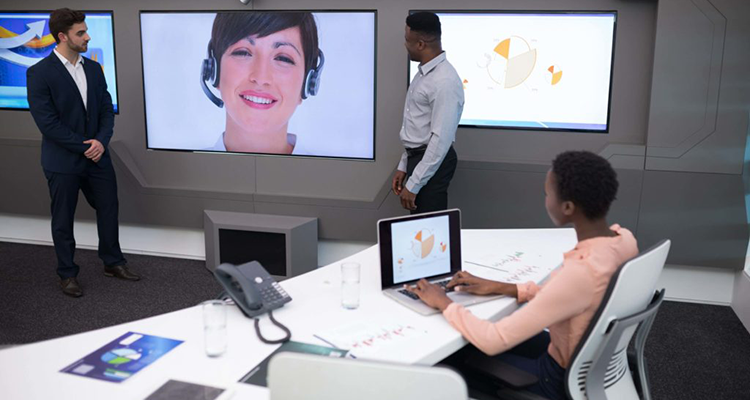A Secret Productivity Killer Called “Double Join” Haunts Most of Our Meetings – And We Deserve Better
 I’d never heard the term “double join” until a few months ago on a call with one of our board members, John Case, who is a great resource to talk with if you’re researching the world of video conferencing. John spent a long time at Microsoft building the Office 365 product family and now puts that knowledge to work by leading a company that focuses on helping enterprises deploy Teams/Skype at scale.
I’d never heard the term “double join” until a few months ago on a call with one of our board members, John Case, who is a great resource to talk with if you’re researching the world of video conferencing. John spent a long time at Microsoft building the Office 365 product family and now puts that knowledge to work by leading a company that focuses on helping enterprises deploy Teams/Skype at scale.
In my (now obsessive) quest to dig into the good, bad and downright problematic parts of videoconferencing, I’ve been on the phone with a lot of great experts in the area. John and I talked specifically about the problem of double join.
So what is a double join? And why should you care?
You’ve encountered this productivity killer if you attend videoconference calls, work in AV or UC to deploy video conferencing, or an enterprise paying for conferencing. That probably covers just about everyone in the workforce – so the problem is widespread.
It’s quite simple. Double join is the need for users, who are sitting right next to one another in a videoconference, to both join the same meeting. You’ll see this whenever more than one person needs to share content in a call. Even if you and I are sitting in the same video-enabled room — and we both might want to share content to everyone in the meeting — we both must dial into the meeting.
Many of us have gotten used to doing this, and I’ve had meetings with a very large bank recently who mentioned that the expectation is that everyone in the room joins the same video conference call from their laptops. I asked them why, and the answer hinted at the importance of content in modern-day meetings: because users may need to share a spreadsheet, a file or their screen at any moment based on the conversational flow of the discussion and you have to be in the meeting to share content regardless of where you are.
Let’s stop and think about how strange this really is.
If I walk into a video-enabled room with my team to meet with external vendors, I’m not asked to join the meeting to turn on my camera. I’m already on camera with the team. This is also true of audio. Of course remote users can hear me; I’m in a room that’s in the call. So why, when I want to share content, do I need to join the meeting? The answer lies in some interesting history of how video conferencing emerged from voice technologies and ignored the content use case early on. This is true for Zoom, WebEx, Teams, GoToMeeting and many other systems. If you spend a few thousand dollars, you can build a pretty great video conferencing room – users can walk into the room, and, fairly simply hold a video/audio conference with remote users. But all this breaks down when content is shared (as it is in most meetings).
Wouldn’t it be cool if I could share content without needing to join the call in the same way that I can, on-demand, make a comment that’s heard by the remote users?
Not only would it be cool; there are three reasons the double join requirement is a problem:
- The user experience sucks. I probably don’t need to belabor this point, we’ve all seen too-true-to-be-funny videos making fun of these issues. Double-join, from a UX perspective looks like this: “Hey I have that spreadsheet. Let me join the call and show everyone.” (big delay) “What’s the code?”And when the new device gets into the call – audio feedback screeches to everyone until I can remember to mute my laptop. “Can you mute? Wait is that my mic? …I’m already on mute…” I then have to ask permission to share my laptop, even though I’m sitting right next to the meeting host, etc… Not only is this a distraction from a smooth meeting flow; it’s simply annoying (and even stressful).Things are like this because the technology was built for remote-to-remote use cases and didn’t contemplate what happens when several people are working in the same space. If this was contemplated – I’m pretty sure the user workflow would not have been designed this way. There’s a huge deficit in human-centered design. Our technology should work the way we work as humans, not require us to engage in a series of backflips simply to share content.
- Double-join costs internet bandwidth (read: real money). It turns out many companies track this cost directly with a fairly complex worksheet that computes the up/down bandwidth used in their video meetings along with a complex equation of where the call originated, how it was routed and other factors. I couldn’t get those companies to share that data with us, but let’s do some simple math.The average U.S. cost of bandwidth to the cloud is about $74 for every Mbps per month. This equates to only .0052 cents per min of bandwidth. Zoom reports that you need about 2Mbps both up and down for each endpoint in a call, so that’s 0.0208 cents/min. We know from our own analytics data that the average meeting involves about 7 participants and, about 2.8 content sources from different devices, in addition to the meeting host in the room are shared during a one hour call. This means for a one hour call, if everyone that’s sharing double-joins, your cost is $4.74 per meeting. Of course, this assumes everyone is double-joined the entire time, but I’ve never seen people drop-off a call once they double-join to save bandwidth.Is this a lot? It is if you’re a financial professional that I recently talked to, who estimates their number of monthly video-enabled meetings exceeds 15,800 worldwide. This is a hard cost of $74,800 that is simply wasted per month.
- Double-join hides the real use case. If you want to understand how to best deploy and support technology in your workplace, then accurate use data is super important. A friend who ran unified communications for Voya once told me they go to great lengths to track room occupancy, call rates and quality to better optimize their software subscriptions and real-estate decisions. In digging in, they discovered that more than 60 percent of their videoconferencing meetings were actually in-room only. Users would join conference calls to enable screen sharing to the room display. He realized that they were overpaying for their unified communications infrastructure by a large amount. When users, whose intent is only to share their screen to the room, are hiding inside of the double-join, you may not know about their true intent. Were they only showing something to their colleagues who are sitting right next to them?Masking these two very different use cases into a single workflow is not only bad for the users but also bad for IT admins, facilities planners and CIOs who need to understand their own meeting culture. Despite reports of “meeting fatigue” being widespread, most employees do find meetings useful – as long as the meeting themselves are useful.Bad user experience is a productivity and morale killer, especially for millennials, who are digital natives that value collaboration — and whose predominance in the workforce has driven significant growth in the adoption of unified communications.
So what’s the answer here? As with anything, we first need to admit we have a problem. Our community (the technology and AV world) is full of very creative, innovative people. Let’s admit double-join is not how things should be and go find a solution!
This column was reposted with permission and originally appeared here.




